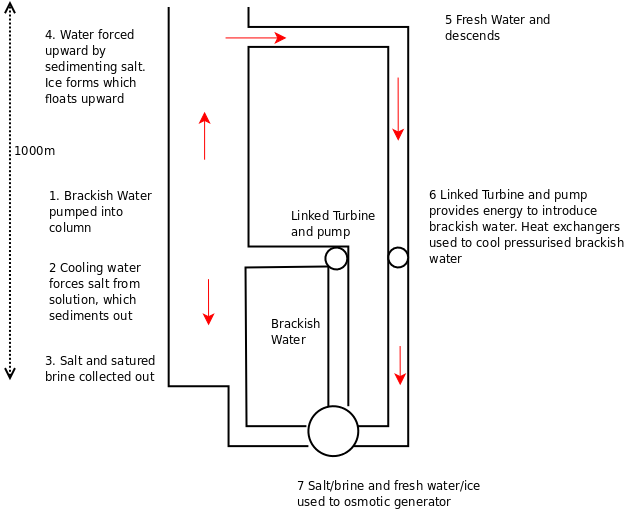
A ThermalSaltSedimentor is a device for seperating salt from water, which can then be combined again in an OsmoticGenerator producing out Renewable Energy.
The system exploits three basic principles. The first is that there is a temperature difference in the atmosphere over height, the second is that if the temperature of salt water is dropped enough, salt will come out of solution, and the third is that ice is less dense than water.
The basic arrangment is shown in the following diagram.
 |
| Diagram of a Thermal Salt Sedimentor |
Firstly, we take a medium salt solution and use it to fill a large column, perhaps 1k in height (probably built up the side of a hill). The water at the top will cool down, and eventually the salt will start to crystallise out. The salt will then start to sediment out, sinking through the column. If the temperature at the top is low is enough, the water will freeze, expelling all of the salt. The ice will start to float to the top. The sedimenting salt will either redissolve as it sinks or form crystals at the bottom.
We now have a column of water with a distinct density gradient of salt, with additional ice at the top and salt of the bottom. The water at the top is now extracted from the column. As it descends, it is used to drive a turbine which in turn pumps brackish water back into the column (some extra Energy would probably be needed to drive this). It would probably make sense to put a heat exchanger between the low pressure, cold, fresh water and the high pressure, warm, brackish water starting the sedimentation process anew. It might even be possible to extract Energy from this temperature differential with a HeatPump.
Finally, the fresh water and salt/satured brine can now be introduced into a OsmoticGenerator from where the output power is produced.
As well as the difficulties associated with the OsmoticGenerator, I can see a number of problems with the system. One of them is that ice and salt are going to be formed in the column. In the idea world, the ice is just going to float and the salt is just going to sink, but in practice, it may crystallise onto the walls of the column, gunging everything up, particularly at the top; if the whole system freezes, then it's going to be hard to pump it down again. It might make sense to build the system so that ice does not form. The salt formation on the other hand is, perhaps, less of a problem, as it should be self limiting. If salt crystalises onto the side of the system, the average salinity will drop, and the water following on will be less concentrated.
There are a number of different ways that you could build this system. Using the side of a mountain would work well, although as the column would have quite a large volume, this might potentially be fairly ugly, although if the system worked well and without frequent intervention, then it could be buried most of the way (obviously it needs to be open to the atmosphere at the top, as it's a heat exchanger). Another way would be to build a tower. If this really needs to be 1km high, as my diagram suggests, this would be a enormous problem. If it works over, say, 200m, then the system would be much more plausible.
Another possibility would be to do the whole thing in batch in a AirShipThermalSaltSedimentor.